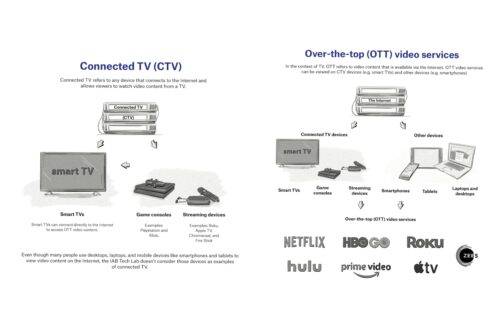
Over-the-top (OTT) and Connected TV (CTV) are two terms that are often used interchangeably by many marketers and brands. Though both of them are separate with their own set of differences, they work in tandem to deliver ads on a connected TV device. But understanding what differentiates OTT and CTV is a good starting point as you integrate streaming into your digital strategy.
Tal Chalozin, Co-Founder and CTO of Innovid Inc. explains, “OTT means you are accessing content ‘over-the-top’ of infrastructure providers. If you’re buying bandwidth from one provider like Comcast but subscribing to Hulu, you are going over-the-top of the provider that provided you the bandwidth. You’re using the bandwidth provider as an access layer but not as the main way you are accessing content. CTV is the device by which you access content. You need an actual device to consume the content. Content is being streamed into an internet-connected app on a Smart TV or similar device.”
In other words, OTT is the term that describes the delivery of TV content through the internet and over the standard, closed TV system. CTV is the term describing any type of TV that is capable of streaming digital video. For example, if a viewer watches Netflix on their mobile device, they are streaming OTT content. But if they watch Netflix through a Chromecast plugged in their TV, they are streaming OTT content on a CTV.

A CTV and OTT representation by Clearcode
advertising
OTT and CTV are different from one another but they work hand in hand when it comes to digital advertising. CTV ads can be brought per programme which means your Data Service Provider likely offers CTV as an advertising channel. This means that you are running ads on a CTV as a channel, but the ads are served over the top.
CTV is a growing market. In 2020, over 6 million US households cut their traditional cable cord, bringing the total number of cord-cutting households to 31.2 million. US and European viewers have been found to prefer free-to-view programming versus a pay-to-watch format where you pay to view the same content without ads. But a big factor to note about CTV advertising is that CTV viewers aren’t on a laptop or mobile with the ability to click on a displayed ad right away. This makes CTV the best place to leverage awareness campaigns. The performance of a campaign in CTV can be tracked using metrics such as video completion rate (VCR) and cost per completed view (CPR). QR codes are also being adopted into CTV advertising strategy.
But there is a notable challenge to advertising this way as well. Each CTV device has its own ID i.e hardware and software which makes it hard to have a unified identifier across all CTV devices. The fact that a viewer can watch the same OTT video content on different devices, adds to the challenge. For advertisers, it becomes quite hard to reach their target audience at a scale within the CTV and OTT landscape. When it comes to setting up advertising in an OTT platform, there are 4 methods you can choose from. We’ve broken it down for you in our blogpost HERE.
conclusion
With in-web and in-app advertising capability, data will play a key role in optimizing reach, performance and measurement in the OTT and CTV landscape. As both the industries grow, the opportunities for newer companies to innovate and problem-solve grows too. Partnerships between brands, media owners and Ad-tech companies is expected to rise.
If you are looking to set the ball rolling on your digital strategy, Enveu is here to guide you all the way. Our expertise covers every aspect of the video streaming sphere, ensuring that your business goals are a perfect fit in the market. So what are you waiting for? Contact us right away.



